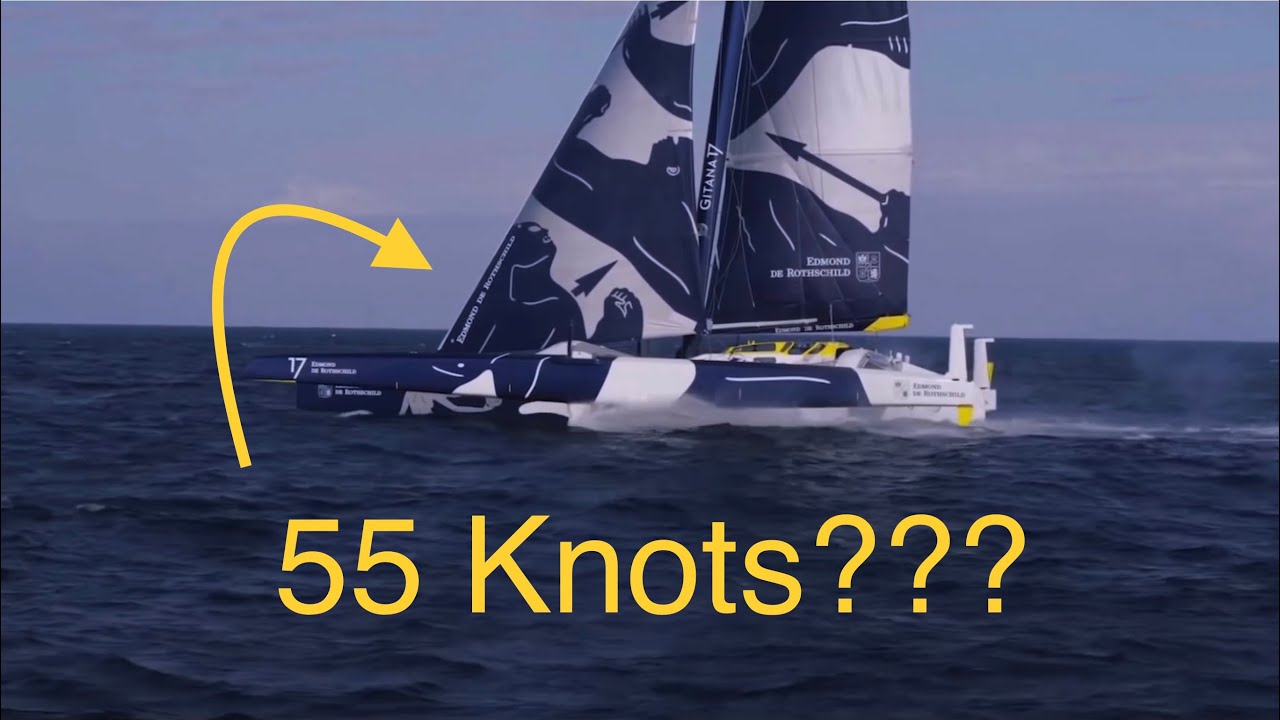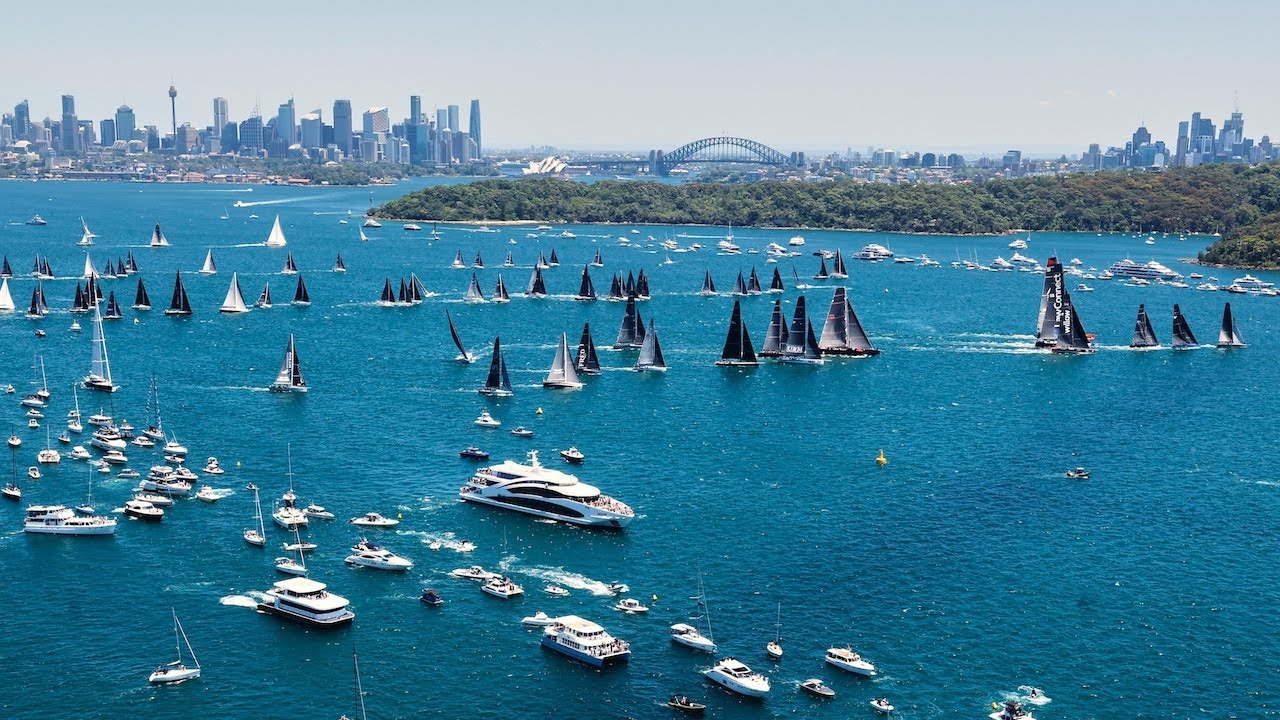În ciuda câțiva ani în care s-a depășit acum, majoritatea recordurilor de navigație din lume sunt încă deținute de bărci care nu slăbesc. Dar dacă bărcile de foiling sunt mult mai rapide, cum de nu au doborât mai multe recorduri? În acest videoclip vom explora de ce. Foiling este atunci când coca unei bărci este ridicată din apă de aripile subacvatice numite hidrofoile, cum ar fi aceste nave International Moth care folosesc folie completă din 2000. Cu cea mai mare medie de 10 secunde pentru o Moth de 35,9 noduri, este cel care a postit. barca de navigație cotată în lume. Prima barcă mai mare care a folosit folie completă a fost L’Hydroptere, un trimaran experimental francez. Ea a doborât recordul de viteză de navigație în 2009, cu viteze de 52,86 KT peste 500M și 50,17 KT pe o milă nautică. Ea a ajuns pentru scurt timp la 56,3 KT, dar nu suficient de mult pentru a se califica ca record, și a pierdut controlul și s-a răsturnat la scurt timp după aceea. Din 2013, ambarcațiunile de la America’s Cup și SailGP au fost, de asemenea, full-foiler, dar, interesant, nici una dintre ele nu a mers încă mai repede decât L’Hydroptere. În 2017 a fost lansat Gitana 17. Ea este primul maxi trimaran oceanic proiectat de la zero pentru folie completă, dar în cei cinci ani în care navighează, încă nu a doborât recordul mondial de non-foiling al IDEC Sport. Unele bărci, cum ar fi ambarcațiunea lui Alex Thomson Vendee Globe Hugo Boss din 2016, sunt proiectate ca foile parțiale, în care coca este încă în apă în mare parte a timpului, dar foliile oferă o oarecare portanță și reduc tanajul. În acest film, Alex și-a rupt folia de la tribord, astfel încât carena lui este complet în apă. Dar, în ciuda faptului că a navigat 2/3 din drum în jurul lumii, cu o floretă lipsă, el a ajuns pe locul al doilea și înaintea barcilor care a depășit în spatele lui. Deci, care e treaba cu bărcile de foiling. De ce nu dețin mai multe Recorduri Mondiale ambarcațiunile cu foile precum Gitana 17? Se datorează faptului că există o mulțime de limitări practice și fizice asociate cu folierea, despre care vom discuta în acest videoclip, dintre care nu în ultimul rând este cavitația la aproximativ 50 de noduri. Disclaimer: – Acest conținut este oferit exclusiv pentru educația și divertismentul dvs. – Nu există garanții, exprese sau implicite, cu privire la orice conținut sau potrivirea acestuia pentru un anumit scop. – Există riscuri de rănire, deces, beție și dificultăți financiare implicate în navigație. – Comandantul este întotdeauna responsabil pentru siguranța navei și a echipajului său. – Sailing Tips nu este responsabil sau răspunzător în niciun fel pentru orice se întâmplă pe sau oriunde în apropierea ambarcațiunii dvs. sau a oricărei ambarcațiuni pe care nu suntem în comandă. #sailing #foiling #howtosail #learntosail #sailingtips
source
Cât de repede poate merge de fapt o barcă cu pânze cu pânze?!?!?

27 thoughts on “Cât de repede poate merge de fapt o barcă cu pânze cu pânze?!?!?”
Comments are closed.




I randomly get to be your first comment. Cool vid on a topic I had not considered. Thanks for putting this together.
so is the future of the fastest boats ones with variable size foils that can be removed from the water fully when winds are to high or low? 😀 a nice engineering challenge
Nice presentation on a very interesting topic. I think it's always been more important to establish high average speeds than ultimate, or fleeting, top speeds in distance ocean racing.
French sail Gp Boat hit 99.9km. That's over 53knots but, no records have been officially attempted.
Well reasoned.
Vive les français a la course au large
The only reason foilers do not hold all the records is that they have not been around as long as conventional boats and therefore they are much fewer in number and have not had as many opportunities to break the records. IDEC holds the RTW record for pretty much one reason: Francois Joyon is an animal, knows how to keep a boat light, and got into a fantastic low pressure moving at 35kt across the Indian Ocean that they were able to remain inside. So the weather system was moving precisely at the maximum speed the boat was able to maintain for eight or nine days, and they demolished the Indian Ocean record in the process. Crewed, with seven guys and the best weather router and skipper in the world. Then a few months later, Francois Gabart took MACIF, a fully foiling trimaran, around the world in 42 days – just missing the fully crewed non-foiling record set by IDEC, but at a much higher average speed, ALONE. Great skipper, great router, but he was only one guy. So foils basically allowed him to maintain much higher average speeds than Joyon did with a fully crewed non-foiling boat, even though Gabart was alone and sleeping much of the time with autopilot driving. Joyon's average speed throught the water was just over 22 knots. Gabart's was 27 knots. There is a certain amount of luck in the weather patterns in these RTW attempts also; IDEC sailed only 26,412 miles, where Gabart traveled 27,859. Gabart's singlehanded foiler would have won handily given similar course distance. Joyon himself suggests that the boat to beat his RTW fully crewed will likely be a foiler capable of sustained 45kt speeds: https://www.sailingworld.com/qa-with-idec-sport-skipper-francis-joyon/
Don't forget attention and concentration of the crew. Normally with and without foils a catamaran is faster than a trimaran (monohulls with foils try to act as a catamaran). But if you are racing around the world your attention and comcentration cannot be all times at 100%. A trimaran forgive much more failures of the crew due to exhaustion than a catamaran.
I’m gonna guess 7…
So this is what the rich people do for fun…..I always wondered.
https://m.youtube.com/watch?v=sZVIj5TUSKE
Hey Dude, nice channel. I do educational sailing content myself as well and i like the way you present your info. I recently started to fiddle with editing more seriously and im suspicious a low level soundtrack on the background does wonders to increase retention. I suggest you try it out
Very nice and intresting videos, thank you. I was about to comment the F50:s speed record in St.Tropez, 99,9 km/h (53,9 kn) but there was smart comments below about it.
No, that is NOT the main reason. #1 reason is that they are UNSTABLE for the same reason a canard aircraft is unstable(roughly speaking). The wave motion increases angle of attack, causing the foil to stall, post max amplitude of wave, crashing the hull at HIGH speed causing a pitch pole. The lifting rudder in the rear can try to counter this moment, but all it really does is dump the entire hull lower to the waves in the same direction of the pitch pole to begin with so the ONLY solution is for a pilot, be it human or computer to anticipate the amplitude and hope and pray you do not have cross waves nor do you have a Big peak wave from cross wave direction so the dumb computer( be it human or not) cannot see this and dumps the boat. Why America's cup races especially are in closed waters for the hydrofoils and never in open ocean. It is why the America's cup always has one guy staring at a computer screen trying to keep the boats foiling. #2 reason you gave and that is Cavitation, though even this is not exactly true as all it really means is one needs a different hydrofoil for this speed regime, just as a supersonic aircraft has a completely different airfoil required for supersonic flight compared to subsonic. With the only problem being the hydrofoil is working in non compressible fluids and an aircraft is not. So, you have to cheat by usually introducing air in front of the foil lowering density. If you think about it, every speedboats and many ships propellers are supersonic. It would not be difficult to add different hydrofoils to these boats… Just takes $$$ and competency in learning to drop the higher speed foil when appropriate.
In short, the problem is applied engineering COST for bragging rights with no real world application. So, no one making these around the world boats gives a damn about technical realities, rather they are just trying to be slightly faster than the next billionaires largesse dumped onto a captain for bragging rights. So, currently for bragging rights it is partial foiling. Maybe in another decade a billionaires bragging rights will require true hydrofoiling to be 1knt faster. Military is not really interested as stealth(subs) is more important than speed or being so blatantly obvious no one can mistake you for a warships presence. And if a military DID go towards hydrofoils they can get most of the benefits by using super long lifting bodies instead of a hydrofoil, but outside the presentation material here.
what about Flying Nikka which has been built to break records (I think)?
50 kts is a barrier where typical flow dynamics don't apply anymore. Practically the problem is more ventilation than cavitation, but nevertheless the result is similar: the foil loses lift and drag increases dramatically. Practical solution could be to design ventilating foils in similar ways than with with surface propellers. The air should be directed into separating zones in low pressure side and the flow would be separated from the foil controlled. The only issue is that the ventilating foil works poorly in lower speeds. But in that case 50 kts is not a barrier anymore.
Toys of the super rich ,
Time for a revolution
Why dont they Dimple the foils like a golf ball to avoid cavitation?
Great video, nice to see this being address seriously. Yeah, it's not safe foiling over long distances, the best helmsmen in the world crash their foiling multis on a regular basis. The Eagle 53 has had its T-foils installed, but they haven't put out a video on this new addition to the design. I suspect that the software required to make the boat foil safely hasn't yet been figured out.
Very interesting! Thanks 👍
France's SailGP boat hit 99.9 kph briefly(just under 54 knots) a few weeks ago, and that is a new top speed record for that race series. They were seriously moving.
So all they have to do is solve the cavitation problem and make adjustable foils and they can go faster?
And then there's Sailrocket at 65.45 knots over 500 meters! Peak speed 68 knots. Must have been some crazy hydrodynamics happening around her single foil.
These Utlim 32 boats are beast, way more interesting than AC boats.
Regarding IMOCA, they are not full foiling boat (i.e. Hugo BOSS )as today, lifting rudders are forbidden.
Engineers knows how to design a foil to push the cavitation limit at high speed. But this mean your foil will be even less efficient in light wind (that's also why it's easier on short race to go faster than 55 knots if such a boat is designed – Syrocco?-). Ultimate class is working a lot on aerodynamics and, from what I know, a lot on a new foil (tip part of the mid hull) that will be in "reverse" (dragging the boat down to the sea where other foil lift) to enable more power to be transmitted form the sails. Next race (Route du Rhum) they should be even faster.
Great video, but I'm not yet entirely convinced by your explanation. Cavitation occurs when the pressure locally gets to below the boiling point of the water, so the water spontaneously turns gaseous, and this can cause stalling of a foil. I understand that this becomes more and more likely at higher speeds for a given angle of attack and foil curvature. But do you have any explanation for this magical number of 50 knots? Couldn't one simply use a slimmer foil profile and a lower angle of attack at higher speeds? Or is this not possible due to structural limitations?
Also I assume you meant "sound barrier" in a figurative way? I see no physical resemblance to the challenge of breaching the sound barrier in aircraft.